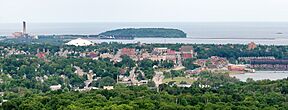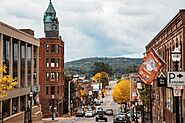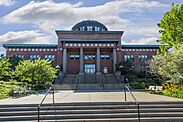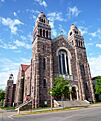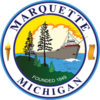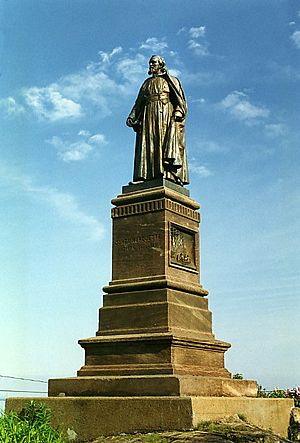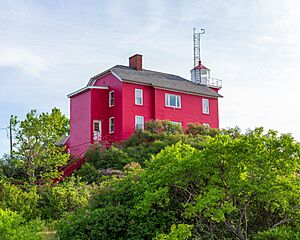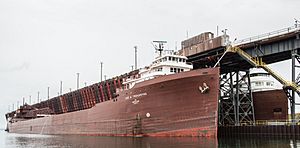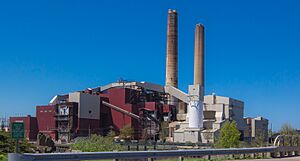Marquette, Michigan facts for kids
Quick facts for kids
Marquette, Michigan
|
||
|---|---|---|
|
|
||
|
||
| Nickname(s):
"Queen City (of the North)", "MQT"
|
||
| Country | United States | |
| State | Michigan | |
| County | Marquette | |
| Settled | 1844 | |
| Incorporated | 1849 (village) 1871 (city) |
|
| Named for | Jacques Marquette | |
| Government | ||
| • Type | City commission | |
| Area | ||
| • City | 19.40 sq mi (50.24 km2) | |
| • Land | 11.34 sq mi (29.36 km2) | |
| • Water | 8.06 sq mi (20.87 km2) | |
| Elevation | 633 ft (203 m) | |
| Population
(2020)
|
||
| • City | 20,629 | |
| • Density | 1,819.62/sq mi (702.55/km2) | |
| • Metro | 67,077 | |
| Time zone | UTC−5 (EST) | |
| • Summer (DST) | UTC−4 (EDT) | |
| ZIP code(s) |
49855
|
|
| Area code | 906 | |
| FIPS code | 26-51900 | |
| GNIS feature ID | 0631600 | |
Marquette (pronounced mar-KET) is the largest city in the Upper Peninsula of Michigan, United States. It is the main city of Marquette County. The city sits on the beautiful shores of Lake Superior.
Marquette is a very important port. It is mainly known for shipping iron ore from the nearby Marquette Iron Range. The city is named after Jacques Marquette, a French Jesuit missionary who explored the Great Lakes region long ago.
In 2020, Marquette had a population of 20,629 people. This makes it the biggest city in Michigan north of the Tri-Cities. It is also the third-largest American city on Lake Superior. Only Duluth, Minnesota and Superior, Wisconsin are larger.
Marquette is home to Northern Michigan University (NMU). This is a four-year public university. NMU's sports teams are called the Wildcats. Their men's ice hockey team even won a national championship in 1991.
Contents
History of Marquette
The area around Marquette was known to French missionaries in the early 1600s. It was also known to fur trappers in the early 1800s. The land was first home to the Anishinaabe people. They called the area Gichi-namebini Ziibing.
The city began to grow in 1844. That year, William Burt and Jacob Houghton found iron deposits. These deposits were near Teal Lake, west of Marquette. In 1845, the Jackson Mining Company was formed. It was the first mining company in the area.
The village of Marquette started on September 14, 1849. This happened when the Marquette Iron Company was formed. Three men helped start this company: Robert J. Graveraet, Edward Clark, and Amos Rogers Harlow. The village was first called New Worcester.
On August 21, 1850, the name was changed to honor Jacques Marquette. The Marquette Iron Company did not succeed. But its next company, the Cleveland Iron Mining Company, grew strong. This company officially planned the village in 1854. The village became an official town in 1859. It became a city in 1871.
During the 1850s, Marquette became a major shipping center. It was connected by train to many mines. The first ore dock was built in 1859. By 1862, the city had over 1,600 people. Its economy was growing fast.
In the late 1800s, Marquette became a popular summer vacation spot. People came by steamships on the Great Lakes. They filled the city's hotels and resorts.
South of the city, K. I. Sawyer Air Force Base was an important military base. It closed in 1995. Now, it is the county's Marquette Sawyer Regional Airport.
Marquette is still a shipping port today. It ships hematite ores and iron ore pellets. These come from nearby mines. About 7.9 million tons of iron ore passed through Marquette's Presque Isle Harbor in 2005.
The Roman Catholic Bishop Frederic Baraga is buried at St. Peter Cathedral. This church is important for the Diocese of Marquette.
Lakeview Arena, an ice hockey rink, won a national contest in 2016. It received $150,000 for upgrades. It also hosted a professional hockey game in October 2016.
Postal History
Marquette has a main post office. There is also a post office at the Northern Michigan University Bookstore.
A special postal card showing Bishop Frederic Baraga was first used in Marquette in 1984. A stamp about Lake Superior was also first used here in 2006.
Geography and Climate
Geography of Marquette
The city covers about 19.45 square miles (50.24 square kilometers). About 11.39 square miles (29.36 square kilometers) is land. The rest, about 8.06 square miles (20.87 square kilometers), is water.
Marquette includes several small islands in Lake Superior. These include Middle Island, Gull Island, and Picnic Rocks. The Marquette Underwater Preserve is right off the shore.
Marquette Mountain is in the city. People ski there in winter. In summer, they ride mountain bikes. Most of the land for Marquette Branch Prison is also in the city.
Marquette's Climate
Marquette has four clear seasons. The weather is greatly affected by Lake Superior. Winters are long and cold. The average temperature in January is about 18.5°F (-7.5°C). The lake makes winter temperatures a bit warmer than places further inland.
Marquette gets a lot of snow in winter. This is mostly from "lake-effect snow." Lake Superior rarely freezes completely. This means lake-effect snow can happen all winter. Marquette is one of the snowiest cities in the United States. It gets about 149.1 inches (3.79 meters) of snow each year.
The warmest months are July and August. They both average about 66.2°F (19°C). Temperatures above 90°F (32°C) are rare. Spring and fall are mild but can change quickly. Spring is usually cooler than fall. This is because the lake warms up slower than the land. In fall, the lake releases heat, warming the area.
Marquette gets about 30.2 inches (767 mm) of rain each year. This rain is spread out evenly. September and October are the wettest months. The city gets about 2,294 hours of sunshine each year.
The City of Marquette is working to adapt to climate change. They are restoring the coastline. They are also moving parts of Lakeshore Boulevard inland. This road sometimes floods from Lake Superior.
| Climate data for Marquette, Michigan (1991–2020 normals, extremes 1857–present) | |||||||||||||
|---|---|---|---|---|---|---|---|---|---|---|---|---|---|
| Month | Jan | Feb | Mar | Apr | May | Jun | Jul | Aug | Sep | Oct | Nov | Dec | Year |
| Record high °F (°C) | 57 (14) |
69 (21) |
82 (28) |
91 (33) |
100 (38) |
101 (38) |
108 (42) |
102 (39) |
98 (37) |
89 (32) |
74 (23) |
60 (16) |
108 (42) |
| Mean maximum °F (°C) | 42.5 (5.8) |
46.5 (8.1) |
57.5 (14.2) |
71.8 (22.1) |
83.1 (28.4) |
88.2 (31.2) |
89.8 (32.1) |
89.3 (31.8) |
84.7 (29.3) |
75.1 (23.9) |
58.8 (14.9) |
46.0 (7.8) |
91.9 (33.3) |
| Mean daily maximum °F (°C) | 24.6 (−4.1) |
26.9 (−2.8) |
35.3 (1.8) |
45.8 (7.7) |
58.7 (14.8) |
67.9 (19.9) |
74.6 (23.7) |
74.3 (23.5) |
67.3 (19.6) |
53.9 (12.2) |
40.6 (4.8) |
30.2 (−1.0) |
50.0 (10.0) |
| Daily mean °F (°C) | 18.5 (−7.5) |
19.7 (−6.8) |
28.2 (−2.1) |
38.4 (3.6) |
49.8 (9.9) |
59.0 (15.0) |
66.2 (19.0) |
66.2 (19.0) |
59.4 (15.2) |
47.0 (8.3) |
34.5 (1.4) |
24.4 (−4.2) |
42.6 (5.9) |
| Mean daily minimum °F (°C) | 12.4 (−10.9) |
12.5 (−10.8) |
21.0 (−6.1) |
31.0 (−0.6) |
40.8 (4.9) |
50.1 (10.1) |
57.7 (14.3) |
58.1 (14.5) |
51.6 (10.9) |
40.0 (4.4) |
28.5 (−1.9) |
18.6 (−7.4) |
35.2 (1.8) |
| Mean minimum °F (°C) | −3.5 (−19.7) |
−2.4 (−19.1) |
5.3 (−14.8) |
20.5 (−6.4) |
31.2 (−0.4) |
39.8 (4.3) |
48.7 (9.3) |
49.2 (9.6) |
39.8 (4.3) |
30.1 (−1.1) |
16.3 (−8.7) |
2.7 (−16.3) |
−8 (−22) |
| Record low °F (°C) | −27 (−33) |
−33 (−36) |
−19 (−28) |
3 (−16) |
16 (−9) |
29 (−2) |
36 (2) |
33 (1) |
28 (−2) |
13 (−11) |
−9 (−23) |
−20 (−29) |
−33 (−36) |
| Average precipitation inches (mm) | 1.86 (47) |
1.47 (37) |
1.59 (40) |
2.74 (70) |
2.90 (74) |
3.05 (77) |
3.11 (79) |
2.31 (59) |
3.34 (85) |
3.43 (87) |
2.42 (61) |
1.98 (50) |
30.20 (767) |
| Average snowfall inches (cm) | 25.1 (64) |
20.9 (53) |
14.2 (36) |
8.4 (21) |
0.3 (0.76) |
0.0 (0.0) |
0.0 (0.0) |
0.0 (0.0) |
0.0 (0.0) |
0.9 (2.3) |
11.1 (28) |
21.1 (54) |
102.0 (259) |
| Average extreme snow depth inches (cm) | 25.2 (64) |
31.7 (81) |
32.6 (83) |
19.3 (49) |
1.5 (3.8) |
0.0 (0.0) |
0.0 (0.0) |
0.0 (0.0) |
0.0 (0.0) |
2.5 (6.4) |
9.1 (23) |
17.9 (45) |
36.1 (92) |
| Average precipitation days (≥ 0.01 in) | 17.7 | 12.2 | 10.8 | 10.4 | 11.8 | 11.8 | 11.3 | 11.0 | 12.9 | 14.6 | 13.4 | 14.4 | 152.3 |
| Average snowy days (≥ 0.1 in) | 17.7 | 12.5 | 8.9 | 4.5 | 0.2 | 0.0 | 0.0 | 0.0 | 0.0 | 0.6 | 7.7 | 12.5 | 64.6 |
| Mean monthly sunshine hours | 105.5 | 128.8 | 181.3 | 225.3 | 278.8 | 289.7 | 322.8 | 270.6 | 191.5 | 140.6 | 80.7 | 78.2 | 2,293.8 |
| Percent possible sunshine | 38 | 45 | 49 | 55 | 60 | 61 | 68 | 62 | 51 | 42 | 29 | 29 | 51 |
| Source: NOAA (sun 1961–1990) | |||||||||||||
People of Marquette
| Historical population | |||
|---|---|---|---|
| Census | Pop. | %± | |
| 1850 | 136 | — | |
| 1870 | 4,000 | — | |
| 1880 | 4,690 | 17.3% | |
| 1890 | 9,098 | 94.0% | |
| 1900 | 10,058 | 10.6% | |
| 1910 | 11,503 | 14.4% | |
| 1920 | 12,718 | 10.6% | |
| 1930 | 14,789 | 16.3% | |
| 1940 | 15,928 | 7.7% | |
| 1950 | 17,202 | 8.0% | |
| 1960 | 19,824 | 15.2% | |
| 1970 | 21,967 | 10.8% | |
| 1980 | 23,288 | 6.0% | |
| 1990 | 21,977 | −5.6% | |
| 2000 | 19,661 | −10.5% | |
| 2010 | 21,355 | 8.6% | |
| 2020 | 20,629 | −3.4% | |
| U.S. Decennial Census 2018 Estimate |
|||
Population in 2020
In 2020, Marquette had 20,629 people living there. There were 8,163 households. About 16% of these households had children under 18. The city's population density was about 1,819 people per square mile.
Most of the people in Marquette were White (90.5%). Other groups included African American (3.6%) and Native American (0.4%). About 2.5% of the population was Hispanic or Latino.
The average age in the city was 40.2 years. About 11.2% of residents were under 18. Many people (30.2%) were between 18 and 24 years old. This is likely due to the university.
Business and Economy
Northern Michigan University is one of the largest employers in Marquette. Other big employers include the Marquette Area Public Schools. UP Health System-Marquette is a major medical center. The Marquette Branch Prison also employs many people. Other companies like RTI Surgical and Charter Communications are important.
Marquette is also known for its local breweries. There were five breweries in the city in 2019.
Marquette's port is important for shipping. In 2015, it was the 140th largest port in the United States by weight of goods shipped.
Fun Things to Do in Marquette
Parks and Recreation
Presque Isle Park is on the north side of the city. It is a beautiful, natural park with lots of trees. A famous landscape architect, Frederick Law Olmsted, visited in 1891. He felt the park should stay mostly untouched. The park has a band shell for concerts and a nature center. There are also picnic areas and walking trails.
Marquette has two beaches: South Beach Park and McCarty's Cove. Both beaches have picnic areas and playgrounds. McCarty's Cove has a red U.S. Coast Guard lighthouse nearby.
Other parks include Tourist Park, Founder's Landing, and Mattson Lower Harbor Park.
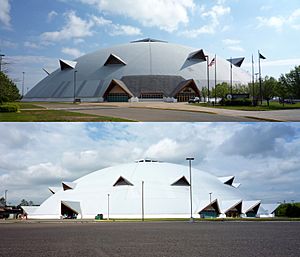
The city has many sports facilities. Lakeview Arena is famous for ice hockey. It also hosts other public events. There is a skateboard park next to the arena. Lakeview Arena was once home to the Marquette Electricians hockey team.
Marquette is home to the Superior Dome. This is the largest wooden dome in the world! It is sometimes called the YooperDome. It is mainly used for football games. Northern Michigan University plays its home games here. The dome also hosts many other events.
The Marquette Golf Club has a famous course called Greywalls. It opened in 2005. This course has amazing views of Lake Superior.
Marquette is also great for fishing. You can catch lake trout, whitefish, salmon, and brown trout.
The city has many paths for biking and walking. These paths are always being expanded. Marquette is known as a great place to walk and live. There are also cross-country ski trails at Presque Isle Park.
You can find camping at Tourist Park. The hilly land and heavy snow make snowboarding and downhill skiing popular right near town.
Museums and Galleries
- The Marquette Maritime Museum is a great place to learn about ships. It includes the Marquette Harbor Light.
- The Upper Peninsula Children's Museum is fun for younger kids.
- The Marquette County History Museum teaches about the area's past.
- The DeVos Art Museum is at Northern Michigan University.
- The Oasis Gallery for Contemporary Art shows modern art.
Festivals and Events
Marquette hosts many fun events throughout the year:
- Art on the Rocks—an art festival at Ellwood Mattson Lower Harbor Park.
- Hiawatha Music Festival—a traditional music festival.
- Marquette's July 4 Celebration—a big party for Independence Day.
- Marquette's Blueberry Festival—celebrating local blueberries.
- UP 200 Dog Sled Race—a famous dog sled race.
- Noquemanon Ski Marathon—a cross-country ski race.
- Marquette Area Blues Fest—a music festival.
- Marquette Scandinavian Midsummer Festival and Wife-Carrying Contest—a unique cultural event.
- U.P. Fall Beer Festival—hosted by Michigan Brewers Guild.
- Ore to Shore—a popular bike race.
- Marquette Marathon—a running race.
- OutBack Art Fair—another art festival.
You can also see live plays at Northern Michigan University's Forest Roberts Theatre. The Lake Superior Theatre offers summer plays.
Getting Around Marquette
Marquette is served by the Marquette Sawyer Regional Airport (MQT). You can fly to Chicago and Detroit from here. The airport is about 20 miles (32 km) south of downtown.
The city has a public bus system called MarqTran. It runs buses through the city and to nearby towns.
Marquette also has freight train service. The Lake Superior and Ishpeming Railroad (LS&I) serves the Upper Harbor Ore Dock. This dock loads iron ore onto large ships. These ships then carry the ore across the Great Lakes.
Several state highways serve Marquette:
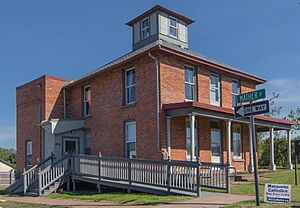
Schools and Learning
Public Schools
The Marquette Area Public Schools serve the city. It is the largest school district in the Upper Peninsula. About 3,100 students attend its schools.
- Marquette Senior High School (grades 9-12)
- Marquette Alternative High School
- Bothwell Middle School (grades 6-8)
- Cherry Creek Elementary
- Graveraet Elementary
- Sandy Knoll Elementary School
- Superior Hills Elementary School
- North Star Academy (a public charter school)
Private Schools
- Father Marquette Elementary School
- Father Marquette Middle School
Universities
- Marquette is home to Northern Michigan University. It is the Upper Peninsula's largest university. It has almost 10,000 students.
Public Libraries
- The Peter White Public Library is a great place to read and learn.
Media in Marquette
Many news and entertainment outlets serve the Marquette area:
- Newspapers: The Mining Journal, The North Wind, and Marquette Monthly.
- Television: WLUC-TV (NBC and Fox), WBUP-TV (ABC), WNMU-TV (PBS), WJMN-TV (MyNetworkTV), WZMQ (CBS and MeTV).
- Radio: WNMU-FM, WHWL-FM, WUPK-FM, WFXD-FM, WUPT-FM, WUPX, WJPD-FM, WUPZ-FM, WKPK-FM, WUPG-FM, WGLQ-FM, WRUP-FM, WNGE-FM, WKQS-FM, WCMM-FM, WMQT-FM, WDMJ-AM, WZAM-AM.
Famous People from Marquette
- Stephen Adamini, a politician
- Mike Bordick, a baseball player
- Edward Breitung, a mine owner and former mayor
- Leonard Brumm, a college hockey coach
- Alfred Burt, a composer of Christmas songs
- Kyle Carr, a speed skater
- Sallie W. Chisholm, an oceanographer
- Robert William Davis, a politician
- Shani Davis, a speed skater
- Susan Diol, an actress
- Dallas Drake, an NHL hockey player
- Nita Engle, an artist
- Robert Erickson, a composer
- Justin Florek, an NHL hockey player
- Vernon Forrest, a boxer
- John Gilmore, an NFL football player
- John Henry Jacobs, a former mayor
- Louis Graveraet Kaufman, a banker
- Alfred V. Kidder, an archaeologist
- John Kivela, a former mayor
- John Munro Longyear, a former mayor and land developer
- Mary Beecher Longyear, a kind helper of others
- John Lautner, an architect
- Helen Maroulis, a wrestler
- Beverly Matherne, a writer
- C. V. Money, a coach
- Jon Morosi, a sportswriter and reporter
- William J. Olcott, a mining executive
- Weldon Olson, a hockey player
- David Palumbo, an illustrator
- Jimmy Peters, Sr., an NHL hockey player
- Hjalmar Peterson, a musician and comedian
- Jeremy Porter, a rock musician
- Chris Rothfuss, a Wyoming politician
- Ralph Royce, a USAF general
- Robert Roosa, an economist
- Bernard F. Sliger, former president of Florida State University
- Sycamore Smith, a folk musician
- Matthew Songer, a surgeon
- Frederic Dorr Steele, an illustrator
- Mary Stein, an actress
- Wendel Suckow, a luger
- Jane Summersett, an ice dancer
- Alfred P. Swineford, a former mayor and newspaper editor
- Peter White, a businessman
Sister Cities
Marquette has two sister cities, which are cities that have special friendly relationships:
See also
 In Spanish: Marquette para niños
In Spanish: Marquette para niños


